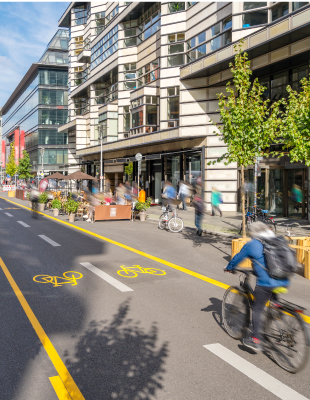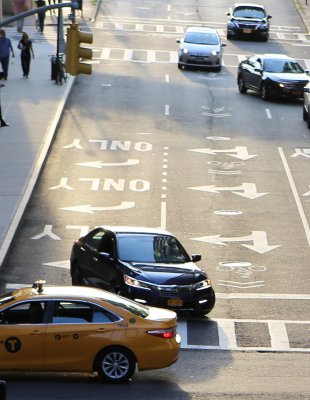Transportation accounts for about 30% of U.S. emissions, making it essential for cities to adopt both multimodal and electrified strategies to meet their climate goals. In 2017, Arcadis and Sam Schwartz/TY Lin City Solutions published Driverless Future 1.0, urging cities to create policies that minimize risks and maximize the benefits of autonomous vehicle (AV) technology.
But where do we stand now? Fast forward seven years, and despite the pandemic and technical challenges, nearly 1,000 robotaxis are now operating in a growing list of cities nationwide. Major cities making headway include San Francisco, Phoenix, Las Vegas, and Los Angeles. But there’s room to grow. From a global perspective, China is leading the way with deployments in 19 cities. Tesla's upcoming announcement about entering the robotaxi market could be a tipping point, but do we truly understand these companies’ game plans?
While evaluating AV technology and its benefits, companies prioritize revenue and try to understand the effects it will have on the bottom line. At the same time, cities desire to see how AVs will improve mobility outcomes, equity, and workforce considerations. These goals can often be at odds but don’t have to be. Although state and federal legislation has regulated AVs, there is a growing need for a localized urban framework that addresses concerns overlooked by current legislation.
As we assess the current state of the market, it's essential to ask critical questions about how to deploy AVs in a way where both providers and cities benefit. As such, we suggest the following framework that focuses on evaluating the success of deployments through three lenses: usefulness, equity, and societal benefits.

The goal of this framework is to support City officials as they look for guidance on AV deployments to ensure these technologies benefit all of their constituents. City officials need to navigate deployment complexities while ensuring initiatives are both technologically sound and socially responsible.
Is It Useful?
Understanding AV technology’s usefulness involves analyzing how it solves real problems and helps users. It must improve individual journeys, enhancing travel experience and reliability at a price point competitive with existing options.
One of the most appealing aspects of autonomous robotaxis is their convenience. For example, the partnership between Waymo and Uber simplifies the process of hailing an autonomous ride. Users can book a ride with a few taps on their phone, and the vehicle arrives at their doorstep, providing door-to-door service. Another useful aspect that could inspire widespread public adoption is how AVs provide an alternative transportation option at a lower price point. Think of it as a less expensive Uber.
The deployment of AVs also tends to be concentrated on the highest demand (highest revenue-generating) routes, such as trips between airports and business districts, as recently seen in Phoenix. While this approach maximizes profits and provides usefulness on a broad scale, it can neglect underserved communities that could greatly benefit from improved transportation options. By prioritizing profit over public service, AV companies risk reinforcing existing mobility gaps rather than closing them.
Is It Equitable?
AV technology must also be equitable. This means making it available for underserved populations that often lack robust transportation options and would benefit the most. This also includes making AVs affordable and universally accessible.
The current fares for AV deployments are often cost-prohibitive and, therefore, not viable as the primary transportation option for the average person. As the technology continues to improve, the operational costs of providing trips (without drivers) are expected to decrease, with the aspiration to make AV services a more cost-effective option than transportation network companies (TNCs) and, in many cases, car ownership. Additional features, such as ride-sharing, may further lower the price and give access to a broader range of users.
The future of lower costs for deployment will also allow for market expansion into underserved neighborhoods, where transit fails to adequately serve day-to-day destinations. Expansion will allow for these areas to reduce reliance on personally owned vehicles and further save on household transportation costs. This stated, equity can co-exist with the current focus on revenue generation. There is a valuable opportunity to enhance equitable access to transportation by expanding AV deployments beyond business districts and profitable areas to include lower-income neighborhoods. Bike-share networks can serve as a positive analog, as they are often launched in the urban cores to stabilize profitable operations, and they have subsequently accomplished this by expanding into underserved neighborhoods.
In the early stages, AV services are not yet optimized for people with disabilities. A lack of wheelchair-friendly autonomous vehicles and the absence of human attendants (a hallmark of AVs) create challenges for riders with mobility issues who may need assistance. The next generation of AV vehicles, such as Holon Mover, the Oceaneering REVO-GT, and Glydways Glydcar, are advancing accessibility through vehicle design innovation.
Is It Beneficial?
Understanding the role AVs have in benefiting the urban landscape, the success of these services will heavily depend on their ability to align with city priorities around mobility and access. More vital collaboration between AV companies and city leaders will be essential to ensure that these technologies contribute to long-term urban mobility goals rather than merely serving as a new form of luxury transportation.
Autonomous vehicles can promote a “car-light” lifestyle by providing additional transportation options that reduce the need for private vehicle ownership. For city residents who may not want or need to own a car, AVs offer a convenient, on-demand alternative that supports a more sustainable approach to urban living. This shift could help cities reduce traffic congestion, lower emissions, and better use limited road space.
In the long term, AV services could also help optimize urban mobility systems by using AI-enabled fleet management to integrate with public transit, improve route efficiency, and decrease fleet sizes. This optimization could lead to fewer vehicles on the road and shorter wait times for users, improving the overall transportation experience.

Driving Toward a Driverless Future
As cities grapple with the rapid expansion of AV technology, they must consider its usefulness, equity, and benefits within the urban mobility landscape. Autonomous vehicles present opportunities to reshape transportation toward a multimodal future which is also a sustainable future. The key to success will lie in how well these services integrate into existing systems and serve the broader public needs. This is why city officials need a framework that can ensure that AV technology contributes to a more sustainable, accessible, and efficient transportation future.
About our authors
Peter Glus is a Senior Vice President at Arcadis who focuses on supporting cities in meeting the needs of their citizens. Drawing on his 30 years of technical experience, collaboration skills, and outside-the-box thinking, Peter applies Arcadis’ unique global capabilities and insights to complex resiliency, sustainability, and mobility challenges.
Corey Clothier, Arcadis’ Global Lead for Automated Mobility, is a leading expert in the automated vehicle (AV) industry. His experience spans more than 60 projects, including collaborations with more than 30 autonomous mobility companies globally. He has developed automated mobility strategies for top clients, including global automakers, the U.S. Department of Defense, state DOTs, and cities around the world.
Joe Iacobucci is a Senior Principal and New Mobility Practice Leader at Sam Schwartz, specializing in sustainable mobility and transportation technology. With more than two decades of experience, he has advised on major projects worldwide, including autonomous vehicle deployments and congestion pricing programs.








